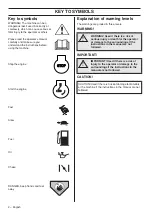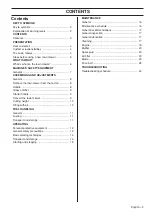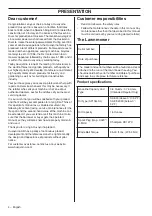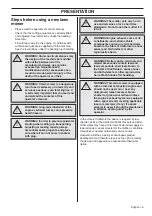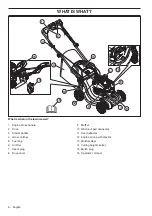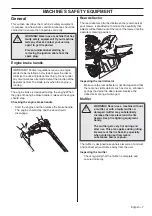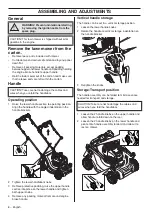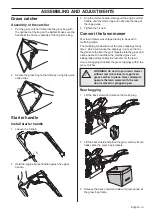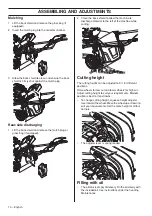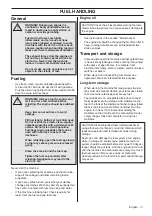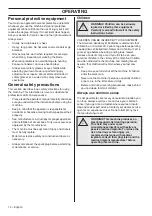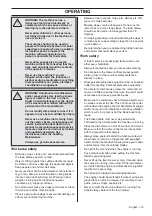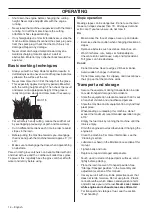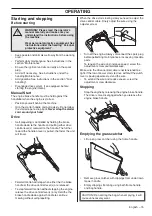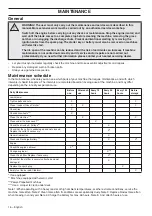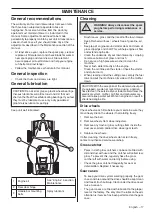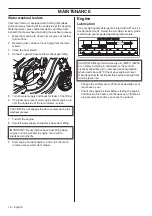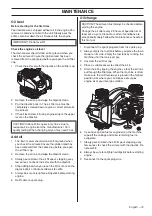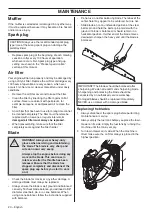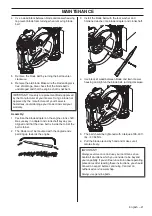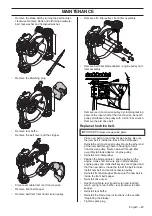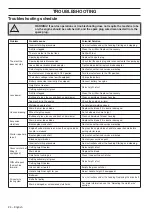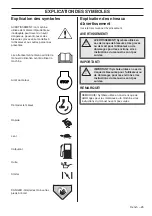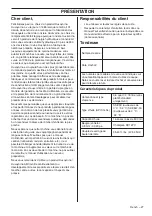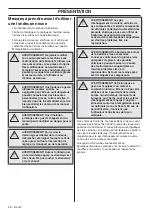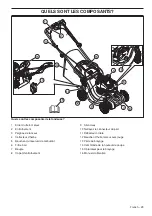
OPERATING
14 – English
•
Shut down the engine before changing the cutting
height. Never make adjustments with the engine
running.
•
Never leave the machine unsupervised with the motor
running. Turn off the motor. Ensure the cutting
attachment has stopped rotating.
•
If any foreign object is hit or if vibrations occur stop the
machine immediately. Disconnect the spark plug wire
from the spark plug. Check that the machine is not
damaged. Repair any damage.
•
Never direct discharged material toward anyone.
Avoid discharging material against a wall or
obstruction. Material may richochet back toward the
operator.
Basic working techniques
•
Always cut with a sharp blade for optimal results. A
dull blade gives an uneven cut and the grass becomes
yellow on the surface of the cut.
•
Never mow more than 1/3 of the length of the grass.
This especially applies during dry periods. Mow first
with the cutting height set high. Then check the result
and lower to an appropriate height. If the grass is
really long, drive slowly and mow twice if necessary.
•
For extremely heavy cutting, reduce the width of cut
by overlapping previously cut path and mow slowly.
•
Cut in different directions each time in order to avoid
stripes in the lawn.
•
Before pulling the machine towards you, disengage
the drive and push the machine forward approx. 3’’ (10
cm).
•
Make sure to disengage the drive when approaching
an obstacle.
Pores in cloth grass catchers can become filled with dirt
and dust with use and the catcher will collect less grass.
To prevent this, regularly hose the grass catcher off with
water and let dry before using.
Slope operation
Mowing slopes can be dangerous. Do not use the lawn
mower on slopes steeper than 15
°
. All slopes demand
extra care. If you feel unsure, do not mow it.
Do:
•
Mow across the face of slopes, never up and down.
•
Exercise extreme caution when changing direction on
slopes.
•
Remove obstacles such as stones, branches, etc.
•
Watch for holes, ruts, bumps or hidden objects.
Uneven terrain could cause a slip and fall accident.
Tall grass can hide obstacles.
Do not:
•
Do not mow too close to edges, ditches or banks.
•
Avoid sudden changes in direction.
•
Do not mow wet grass. It is slippery, and tires can lose
their grip so that the machine skids.
Transport and storage
•
Secure the equipment during transportation in order
to avoid transport damage and accidents.
•
Store the equipment in a lockable area so that it is out
of reach of children and unauthorized persons.
•
Store the machine and its equipment in a dry and frost
proof place.
•
When loading or unloading this machine, do not
exceed the maximum recommended operation angle
of 15
°
.
•
Empty the fuel tank by running the machine until the
tank is empty.
•
Drain the engine oil as described under Changing the
engine oil.
•
Clean the machine. For more information, see the
”Cleaning” section.
•
Lubricate as shown in the Maintenance section of this
manual.
•
Tighten bolts and nuts.
•
Replace or repair damaged components.
•
Touch up all rusted or chipped paint surfaces, sand
lightly before painting.
•
Place the lawn mower in Transport position. See
”Storage/Transport position” in the Assembly and
adjustments section of this manual.
•
Cover your unit with a suitable protective cover that
does not retain moisture. Do not use plastic. Plastic
cannot breathe, which allows condensation to form
and will cause your unit to rust.
Never cover mower
while engine and exhaust areas are still warm!
•
For transport and storage of fuel, see the section
"Fuel handling".
MAX 1/3


